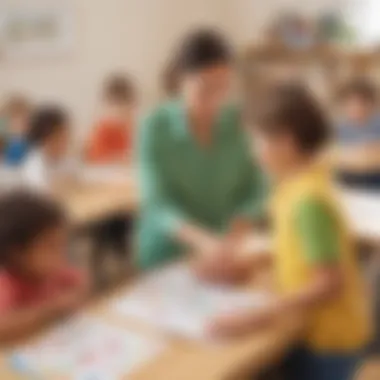Understanding Skip Counting: Boosting Early Math Skills


Intro
Skip counting plays a foundational role in early mathematics education. It refers to counting by a specific number rather than just ones. For example, you can skip count by twos (2, 4, 6, 8) or fives (5, 10, 15). Mastering this skill has numerous benefits, enhancing both children’s numerical literacy and their overall understanding of math.
In this article, we will look closely at skip counting's significance in young learners’ development. It will address practical strategies that parents and educators can implement. Worksheets will be highlighted as effective tools for fostering this essential skill. Additionally, this piece will examine related activities that deepen learning experiences.
We aim to gain a comprehensive understanding of how skip counting assists in connecting different mathematical concepts. By using engaging strategies, you can inspire children to see numbers as more than mere symbols, but as elements that communicate patterns and relationships.
Fun Activities Ideas
Engaging children in fun activities cultivates a rich learning environment for skip counting. Different types of activities can help reinforce this skill.
Indoor Activities
- Counting Games: Use small toys or household items to practice counting. For instance, arrange blocks in specific groups and have children skip count the total.
- Board Games: Games like Chutes and Ladders promote counting and can easily integrate skip counting when appropriate.
Outdoor Adventures
Utilizing the outdoors allows children to connect with nature while learning. For skip counting, take a nature walk and count sets of items, like trees or flowers, in groups of threes or fives.
Arts and Crafts
Craft projects involving scissor skills and measuring can integrate skip counting. Children can count how many paper cuts they make while assembling a collage. They can try to skip count with colors in their artwork.
Science Experiments
Simple science experiments can involve counting ingredients in specific numbers. For example, make a fizzy volcano using baking soda and vinegar, counting out portions in twos or fives.
Cooking and Baking
Children naturally love working in the kitchen. Involve them in skip counting through measuring ingredients. If cookies require three cups of flour for every batch, they can count collections using fractions.
Educational Games
Games remain an excellent method to reinforce learning with pleasure across numerous fields. Here are some suggested educational games that promote skip counting.
Math and Logic Games
Tools like Sum Swamp and Number Ninja will make math fun. These games often pivot around different counting techniques, enhancing skills like addition and multiplication in a playful manner.
Language and Vocabulary Games
Make use of vocabulary words that incorporate skip counting. Try word finds where the words have skip counting multiples, connecting both math and language.
STEM Activities
STEM encourages hands-on learning. Count as children build with construction sets like LEGO, where they can easily manage different numbers and patterns while being creative.
history and Geography Puzzles
Puzzles can incorporate historical counting techniques. Learn how different civilizations counted years, while children create their timeframes by skip counting.
Interactive Learning Apps
There are various apps tailored to today’s learners. Consider apps like ‘Todo Math’ as useful in integrating skip counting within engaging digital interactions.
“Engaging teaching materials can profoundly influence young children's mathematical outcomes.”
Seasonal and Holiday Activities
Capitalize on seasonal themes and holidays to include skip counting activities. Children often become more invested in learning when the background feels relatable or festive.
Valentine's Day Crafts
Incorporate craft ideas like skip counting candles. Number heart-shaped pieces and use them to practice different skip counting intervals.
Halloween Costume Ideas
Design costumes in sets for trick-or-treating. For instance, kids can plan for groups of ten candy pieces.
Thanksgiving Cooking Projects
Explore groupings with creating meals or desserts. Counting potatoes by threes or apples by fives can add numbers into the kitchen tasks.
Christmas Decorations


Create home decorations that follow a skip counted motive. Lights can alternatively emphasize groups of four or six.
New Year's Resolutions for Kids
Encourage children to share their resolutions. Represent their choices in skip counted lists to connect their personal goals with math.
Parenting Tips and Resources
Parents play a critical role in supporting children’s education through reinforcement at home. Below are helpful suggestions.
How to Encourage Creativity
Promote a playful environment where creativity thrives. Work together on projects that let creativity and skip counting shine simultaneously.
Setting up a Playful Learning Environment
A space dedicated to activities, such as learning centers or art corners, solidifies habits to learn while enjoying.
Balancing Screen Time and Playtime
Establishing a ratio helps children experience both tech education and real-world activities avoiding overreliance on screens. Try tools like ‘Khan Academy Kids’ for balance.
Building Strong Family Bonds
Working on skip counting during family game nights protects time in relationships and helps enhance early math skills.
Motivating Kids to Stay Active
Adopt games that emphasize physical counts, instilling healthy habits while learning important mathematical concepts.
Fun Facts and Trivia
Facts can coax curiosity. Exploit children's natural wonder about the world around. Use trivia that ties into numbers.
Animal Kingdom Discoveries
Fact programs supply ways to discuss numbers connecting species and families and constituent food chains.
Famous Inventions Stories
The number of attempts before a successful invention often sparks interest. Use these instances to practice skip counting.
Historical Events for Kids
Major dates in history vary, which can provide insight and understanding of why time can skip count across ages.
Mythical Creatures Explorations
Share stories connected with mythical creatures using patterns. Always relate structures while counting their lineages.
Space Adventures and Discoveries
Look outside for counting experiences, relating distances and objects across the universe using skip patterns.
The integration of worksheets and these varied activities can immensely boost comprehension. Through consistent application, along with creative strategies, children embrace skip counting techniques, helping them perform more effortlessly in mathematics.
Intro to Skip Counting
Skip counting serves as a fundamental building block in early mathematics education. This technique not only aids in the comprehension of numbers, but also establishes connections to various mathematical concepts. It encourages learners to recognize and utilize numerical patterns, laying the groundwork for more intricate arithmetic operations. In doing so, children develop a sense of numerical fluency, which is the overarching goal of mathematics instruction.
Definition and Importance
Skip counting refers specifically to the process of counting forward or backward by a number other than one. Common patterns include counting by twos, fives, and tens. For instance, counting by twos yields the sequence 2, 4, 6, 8, and so on. Understanding skip counting is crucial not just for academic achievement but also for real-life applications, such as making sense of money and time. By grasping these patterns, learners can simplify tasks involving addition and subtraction.
Recognizing the patterns in skip counting allows children to navigate complex problems with ease. It develops procedural skills that serve as a segue into more complex arithmetic—like multiplication. Moreover, skip counting is often utilized when calculating change in monetary transactions, underlining its practical significance.
Cognitive Benefits
Mastering skip counting facilitates a range of cognitive development outcomes. Research indicates that concentration, memory, and problem-solving skills improve as a result of engaging with numbers in a structured manner. For young children, structured practice in skip counting contributes to enhanced mathematical reasoning skills.
Moreover, skip counting helps to sharpen a learner's attention to detail. Children must focus intently on number patterns to successfully skip count. Regular practice strengthens neural pathways related to numerical understanding, which can improve overall cognitive function. As students gain confidence through regular exposure to skip counting, they foster a positive attitude toward learning mathematics.
Key Cognitive Benefits of Skip Counting:
- Enhances numerical understanding and fluency.
- Improves concentration and attentiveness.
- Bolsters memory through repeat pattern recognition.
- Facilitates problem-solving skills by establishing connections between numbers.
- Develops procedural approaches in mathematical operations.


It becomes clear, then, that incorporating skip counting into a child's learning routine offers significant intellectual advantages. As educational tools such as worksheets reinforce this essential skill, they become invaluable in a young learner's development to cultivate a strong mathematical foundation.
Mathematical Concepts Related to Skip Counting
Skip counting forms a foundational aspect in the early understanding of mathematics. It allows learners to grasp essential mathematical principles at a very young age. This simple method holds significance for various advanced mathematical concepts and helps build confidence in arithmetic skills.
Pattern Recognition
One of the crucial of skip counting is the promotion of pattern recognition abilities among children. These patterns often emerge as learners skip through numbers, strengthening their overall numerical literacy. For example, when children skip count by twos, they notice the even numbers form a distinct pattern: 2, 4, 6, 8, and so on.
Being able to detect such patterns promotes critical thinking. Children learn to identify sequences and develop skills to predict what comes next. This could expand to more complex mathematical notions later, like sequences found in multiplication tables. Notably, visual aids, such as number lines, can enhance this recognition. When children can visually see the jumps, the patterns become clearer in their minds, aiding their future math learning. This skill will not just aid them in elementary education but will assist them in high school algebra and understanding concepts like functions.
Multiplication Foundations
Skip counting lays the groundwork for multiplication. Learning to count by grouping solidifies the relationship between addition and multiplication. It shows how multiples are just repeated addition of numbers. For instance, counting by fives, 5, 10, 15, helps learners set a calculation base as these numbers relate seamlessly to multiplication facts: 5 times 1, 5 times 2, and so forth.
This early exposure helps cement the understanding that multiplication is an extension of addition rather than a completely different operation. Associating skip counting with multiplication allows children to build a conceptual framework. Thus, throughout their schooling, they can more easily link these essential arithmetic operations when tackling more complex problems.
Understanding early mathematical concepts is key to fostering confidence in young learners.
Summarizing, the mathematical concepts surrounding skip counting, notably pattern recognition and multiplication fundamentals, are central to a child’s early math education. Mastering skip counting makes for smoother transitions to higher-level math concepts and enhances overall quantitative reasoning skills.
Types of Skip Counting
Understanding the different types of skip counting enriches the mathematical experience for young learners. It encourages students to notice patterns, focus on efficient counting, and grasp underlying number concepts. Each method uniquely contributes to building a foundational understanding that links early math skills to larger mathematical ideas.
Skip Counting by Twos
Skip counting by twos is crucial for several reasons. First, it helps children understand the even numbers. Recognition of these numbers is essential when they begin operations involving addition and subtraction. Once skip counting is mastered, students can easily transition to more complex material, such as basic multiplication.
When children skip count by twos, they articulate a rhythmic sequence: 2, 4, 6, 8, and so on. This repetition reinforces number recognition. Worksheets designed around this concept can vary. Here are a few ideas:
- Fill-in-the-blank exercises
- Color-coding pairs of numbers
- Connecting dots to create shapes or figures that unveil certain images
These engaging activities help keep young learners motivated and interested.
Skip Counting by Fives
Skip counting by fives further bridges the gap in numerical understanding. It is often considered a precursor to learning the multiplication tables of five. This counting technique showcases how adding five expands the number line – from 5, 10, 15, up to 100 and further.
Such practice aids students in recognizing multiples, which is especially beneficial when they transition into division. Worksheets focusing on skip counting by fives can incorporate:
- Tally marks to visualize counting
- Interactive games that require quick responses to number cards or flashcards
- Craft activities, where kids create number lines or charts tagging every fifth numeral
Skip Counting by Tens
Finally, skip counting by tens consolidates young learners' numerical skills, contributing directly to their higher comprehension of math. When children skip count by tens, they not only focus on 10, 20, 30 etc., but they also relate it to their understanding of two-digit numbers.
Practicing skip counting by tens yields practical skills, such as budgeting or working with money. Worksheets may feature:
- Place value exercises that link tens to hundreds
- Real-life situational problems, like skipping count to buy ten items of a common modular item – mirroring retail experiences
- Board games designed with strategic movements dependent on catching tens at every turn
Encouraging skip counting enhances number sense and prepares young minds for advanced processes in mathematics.
This approach creates an interwoven strategy where skip counting grows extensively more influential in the understanding and application of mathematical concepts. Rather than only seeing numbers as abstract figures, children learn to appreciate their relationships and intrinsic structures, vital for long-lasting proficiency in mathematics.
Creating Engaging Skip Counting Worksheets
Creating effective skip counting worksheets is essential for fostering math skills in young learners. These materials provide structures that support understanding, while engaging children in ways that traditional teaching methods may not. An engaging worksheet can nurture enthusiasm for mathematics and help with deeper cognitive processing skills.
Design Principles
When developing skip counting worksheets, certain design principles should come to the forefront. These principles ensure that the worksheets are not just functional but also appealing and effective. Simple usability is key. The layout should minimize confusion and distractions. Clear instructions should guide the children, so they know what is expected.
Contrast is important too. Different colors can designate different steps within the worksheet, helping enhance overall clarity. Engagement may increase when children see vibrant colors, especially if colors are connected to what they are learning.
Another aspect involves using a logical progression of difficulty. Begin with simpler tasks and gradually introduce more challenging concepts. This incremental approach helps maintain children's motivation and reinforces concepts consistently.
Incorporating Visual Elements
Visual elements in worksheets help enrich the learning environment. They serve to capture and hold a child's attention, facilitating better understanding. Pictures, symbols, and graphics enhance the comprehension of skip counting. For instance, using images of groups of objects can clearly represent the idea of counting by twos or fives.
Using charts can reinforce the concept of symmetry or patterns. For example, a number line with visuals – like dots or shapes – can visually depict how numbers relate in a skip counting setting.
Visual aids can become a strong reinforcement mechanism. Gradually discussing these illustrations alongside numeric concepts solidifies children's grasp upon reason why skip counting exists in math.


Differentiated Instruction Strategies
One size does not fit all when it comes to teaching. Differentiated instruction strategies are essential for addressing various learning needs among children. For instance, worksheets can be designed to cater to Visual, Auditory, and Kinesthetic learners alike. Each element can be siloed by type.
One way to cater to diverse needs is by offering worksheets at varied difficulty levels. Advanced learners might benefit from challenges that involve more complex skip counting tasks, such as converting between units or finding patterns. Though less experienced students might focus on basic counting sequences.
Incorporating different types of activities in each worksheet can create broader interaction opportunities. Puzzle formats or matching exercises can reinforce learning while keeping motivation from waning.
Engaging worksheets in mathematics foster deep learning through differentiated strategies, adapting to each child's unique needs effectively.
Practical Applications of Skip Counting
The practice of skip counting is not limited to abstract math exercises. It presents several practical applications that extend the learning environment for young learners. These applications empower children to relate mathematical concepts to their everyday lives, reinforcing their cognitive skills. Mastering skip counting helps build a robust foundation in mathematics and fosters critical thinking.
Real-life Examples
When discussing skip counting, it is essential to illustrate how these skills apply in real-life settings. Here are some examples:
- Counting Money: For children, handling money can provide a tangible understanding of skip counting. For instance, counting coins in increments of five or ten is relevant when purchasing items. This experience solidifies their understanding of both skip counting and basic financial literacy.
- Measuring Ingredients: In cooking or baking, children can benefit from skip counting as they measure ingredients. If a recipe calls for three cups, using skip counting to measure stability can help them with practical math applications in the kitchen.
- Distance and Time Estimations: Kids may practice skip counting while estimating distances and times during travel. Asking a child to count the number of steps in tens while walking can help them connect skip counting directly with physical activity.
Games and Activities
Incorporating play into learning enhances student engagement. Games and activities that focus on skip counting are particularly effective. Here are some worth considering:
- Skip Counting Hopscotch: Create a hopscotch layout that contains numbers in a skip counting sequence, like two, four, six, etc. As children jump on each number, they can verbalize their skip counting process, making it a fun way to practice.
- Skip Counting Songs: There are many educational songs that teach skip counting rhythms for kids to learn through music. Singing and clapping can strengthen memory retention while keeping the learning light-hearted.
- Board Games: Use board games integrated with skip counting. For example, during a game of ‘Snakes and Ladders,’ when taking steps, players can count out loud using some skip counting strategies to advance accordingly.
These practical applications ensure that skip counting is not mutable to the classroom but connects with everyday activities that foster rigorous learning.
Through these examples and games, children begin to appreciate the utility of skip counting beyond mere academic exercises. The blend of real-world examples coupled with engaging games plays a vital role in deeper learning and overall success in mathematics.
Assessment and Evaluation
Assessment and evaluation play a critical role in understanding how well students grasp skip counting concepts. This segment focuses on the specific aspects of measuring progress and the mechanisms for providing feedback.
Measuring Progress
Measuring the progress of young learners is crucial. Regular assessment helps parents and teachers identify areas of strength and those needing improvement. Assessments can take many forms including informal observations, quizzes, and worksheets specifically designed for skip counting.
- Informal Methods: Engage students in group activities. Observe how they respond to questions while skip counting aloud. Such methods can uncovers insights not obtained through written tests.
- Quizzes: Create fun, short quizzes focused on skip counting by twos, fives, or tens. This not only allows educators to gauge comprehension but also helps challenge and motivate children when they make progress.
- Worksheets: Utilize engaging skip counting worksheets that track student progression through marked grades or colors. This way, educators can point out specific skills achieved.
Regular assessments prevent knowledge gaps and target areas that require more focused teaching strategies.
Feedback Mechanisms
Feedback is essential in creating a learning environment conducive to growth. Young learners benefit from specific, actionable feedback. There are a few ways to implement effective feedback mechanisms:
- Immediate Visual Feedback: Incorporating games or interactive worksheets with instant results. For example, software that shows immediate correctness of skipped count answers encourages improvement.
- Constructive Remarks: When checking homework or assessments, give personalized feedback. Tell students what they did well and how they can improve upon areas lacking understanding.
- Peer Review: Encourage students to work in pairs for skip counting exercises. They can provide guidance and critique each other’s methods. This encourages cooperative learning and independent thinking.
Resources for Parents and Educators
The role of parents and educators is pivotal in laying a strong foundation for young learners. In this context, understanding skip counting is particularly significant. The resources designed specifically for guiding both parents and educators can explore methods to incorporate skip counting in everyday learning, enhancing children's mathematical capabilities.
With the right materials and tools, significant improvements can be made, which encourage students as they advance in their education. These resources facilitate teaching methods, offer comprehensive strategies, and present a variety of engaging activities that sustain learner's interest.
Recommended Books and Materials
Providing young learners with a solid background in skip counting requires utilizing well-written books and well-crafted materials. Parents and educators may consider the following options:
- Books that provide practical exercises: Titles should feature engaging visuals and offer accounts that make learning feel like play.
- Activity books that foster learning: These books typically focus on step-by-step exercises, bringing clarity to skip counting methods while allowing for creativity.
- Flashcards and visual aids: These tools effectively aid retention of learned material through repetition and practice.
Some recommended titles for building a strong base include: "Skip Counting with Animals" by Jodi H. Berenfield, or "Counting on It! Math Start" by Stuart J. Murphy. Both present content that captures children’s fascination while building essential skills.
Online Tools and Platforms
In our fast-paced digital world, utilizing online resources for teaching can provide a format that is adaptable and immediate. This leads to engaging and interactive learning atmospheres. Hence, exploring various platforms can enhance conclusions reached up until now. Some important choices include:
- Educational Websites: Websites like Khan Academy and ABCmouse deliver interactive tutorials on skip counting and other mathematical concepts.
- Mobile Applications: Apps such as Endless Numbers or Montessori Numbers offer portable, fun learning experiences that allow children to practice at their own pace.
- Webinars and Online Forums: platforms, like Reddit, offer communities where parents can share their experiences and resources with skip counting, noting both challenges and successes.
Integrating diverse resources, both printed and digital, allows a more comprehensive understanding of skip counting for young learners. It cultivates long-lasting skills essential for their educational advancement.
By equipping parents and educators with these varied resources and materials, the teaching of skip counting becomes a more systematic, enjoyable, and rewarding endeavor.
Culmination
The conclusion serves a significant role in understanding skip counting. By summarizing the key points, it reinforces essential concepts that were discussed throughout the article. This synthesis aids both learners and educators in recognizing the multiplicative progression that skip counting provides. Understanding skip counting is crucial for laying the groundwork in mathematics.
Recap of Key Points
In this article, we explored several essential elements concerning skip counting.
- Definition and Importance: Skip counting is not simply a method of counting. It's a fundamental skill in early mathematiics learning.
- Cognitive Benefits: Mastery of skip counting leads to improved number sense and better mathematical reasoning.
- Mathematical Concepts: Skip counting helps promote pattern recognition and lays a foundation for multiplication.
- Types of Skip Counting: We've covered skip counting by twos, fives, and tens, showcasing its versatility and applicability.
- Engaging Worksheets: Creative designs are vital in making learning enjoyable. Worksheets hold the key to consolidating learning.
- Practical Applications: We discussed real-life examples and activities that highlight how vital skip counting is daily.
- Assessment: Evaluating progress through various mechanisms is paramount.
- Resources: Lastly, the importance of having mixed resources ensures that various learning styles are catered to effectively.
By presenting these crucial aspects, the article makes a strong case for the learning and application of skip counting, encouraging adoption in various educational contexts.



